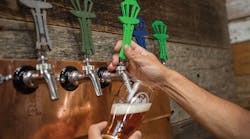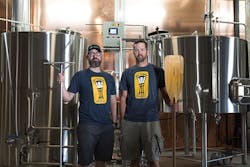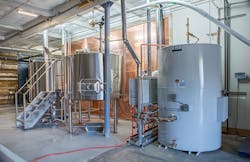VANCOUVER, WASH. — If you’re talking about beer, it all starts with hot water. That’s according to Eric Surface, owner and co-founder of Mt Tabor Brewing Company based in Vancouver, Washington, a suburb of Portland, Oregon.
For Surface, brewing started as a hobby. A commercial fire sprinkler system sales manager by trade, Surface and a group of friends began experimenting in a garage in Portland brewing 30 gallons at a time. By 2010, their passion had transformed into something resembling a business and the group founded Mt Tabor Brewing Company.
“We’re just a small, little brewery that started as a hobby and slowly transitioned into a ‘jobby,’” Surface joked.
In a metro area with more than 40 craft brewers, Mt Tabor has done well to grow into a brewery that produces more than a dozen craft beer varieties, including top sellers Asylum Ave IPA, Crown Point Porter and Powell Butte Pale Ale.
Since 2011, Mt Tabor has operated out of a brewing facility in Vancouver just across the Columbia River from downtown Portland. The brewery produces 200-gallon batches — roughly 170 barrels annually.
But the time has come to expand the operation to meet greater demand, and the growth opportunity has empowered Surface to rethink Mt Tabor’s brewing process.
No. He’s not recalculating the hoppy, balanced formula that’s made his easy drinking beers popular. Surface has taken the expansion opportunity to re-think his hot water system.
From start to finish, each batch of beer requires 350 gallons of hot water in specific intervals and specific temperatures, so we knew we needed an efficient and reliable hot water system to keep up with our demand.— Eric Surface
“Everything you do in the brewing process uses hot water,” said Surface. “From start to finish, each batch of beer requires 350 gallons of hot water in specific intervals and specific temperatures, so we knew we needed an efficient and reliable hot water system to keep up with our demand.”
In addition to activating enzymes in the grain, Surface says water heated to 160 degrees is used to clean the large stainless steel equipment that produces the brew and to wash the kegs that hold the finished product.
Surface learned quickly the limitations of the hot water system at Mt Tabor’s 1,100-sq.ft. Vancouver facility. Inside, one 250-gal. storage tank equipped with three electric heating elements would bring the water to temperature.
“The problem is once the hot water was used for the day, it would take several hours until you could get hot water again,” Surface said. “Hot water was almost always the biggest hold up.”
And that’s a big problem for a brewery because the process begins and ends with hot water.
Surface worked with experts at A. O. Smith to develop a reliable hot water system that can meet the high demands of Mt Tabor’s new 6,000-sq.ft. facility in downtown Portland, which opened summer 2016.
Inside the new Portland brewing facility, Surface wanted the capacity to produce 200 times more beer a year than what was possible at the Vancouver location.
“In Vancouver, we’re producing 170 barrels a year,” Surface said. “At the Portland brewery, we want to produce 90 to 120 barrels a month — and 180 to 200 barrels a month in the future.”
To meet Mt Tabor’s increased demand for hot water, A. O. Smith recommended three ATI-540H-N tankless water heaters. These models fully modulate between 15,000 BTU/hour and 199,000 BTU/hour to deliver a maximum flow rate of up to 10.0 gallons per minute per heater while conserving energy when lower flow rates are needed. The ENERGY STAR-qualified unit utilizes condensing technology to achieve an Energy Factor of 0.95 and meets Ultra-Low NOx emission requirements.
To simplify installation of the condensing tankless models, A. O. Smith recommended a new technology — A. O. Smith’s Tankless Commercial Rack System. Constructed on a durable, lightweight aluminum frame, this new system reduces installation costs by having gas and water manifolds pre-assembled at the factory.
The Tankless Commercial Rack System is adaptable, too. To meet peak hot water demands, A. O. Smith paired the system with a TJV500 Storage Unit, a glass-lined, fiberglass-wrapped unit capable of keeping up to 500 gallons of hot water at temperature for days on end.
“Mt Tabor’s entire business process revolves around hot water, so we knew we had to provide products that would save them time and money and keep up with their needs,” said Rob Olson, P.E. and plant manager at A. O. Smith’s commercial manufacturing facility in Renton, Washington.
“The commercial tankless rack system arrived pre-plumbed, so installation was quick and easy,” Surface said. “We hooked up the gas and water lines to the pre-installed rack system manifolds and then connected the system to the storage tank. It was amazing how quickly the system went together.
“It fits our space perfectly,” Surface said.
Surface says he sees tankless water heaters as a good investment. The new system has cut the brewery’s start-up time each morning to about 20 minutes, and the current setup can easily double the brewery’s capacity without upgrades.
“As a business owner, the best part about A. O. Smith tankless units is how fast they heat up and how efficient they are,” Surface said. “They work hard for us during the day when we need hot water and then go into standby mode when we don’t need hot water. It’s a huge time and money saver, and as any good businessman knows, time and money are the pillars for a growing company.”
Having experienced how easy the A. O. Smith Commercial Tankless Rack System was to set up in his own brewery, Surface says a rack system is great fit for the craft brewing industry because of its energy efficiency and simplicity. Additionally, a tankless system allows water heaters to be isolated for service while the other units continue delivering hot water.
“It all starts with hot water: If you don’t have hot water, you can’t make beer,” said Surface. “The peace of mind that comes from us being able to turn a switch and have a reliable source of hot water cannot be overstated.”





